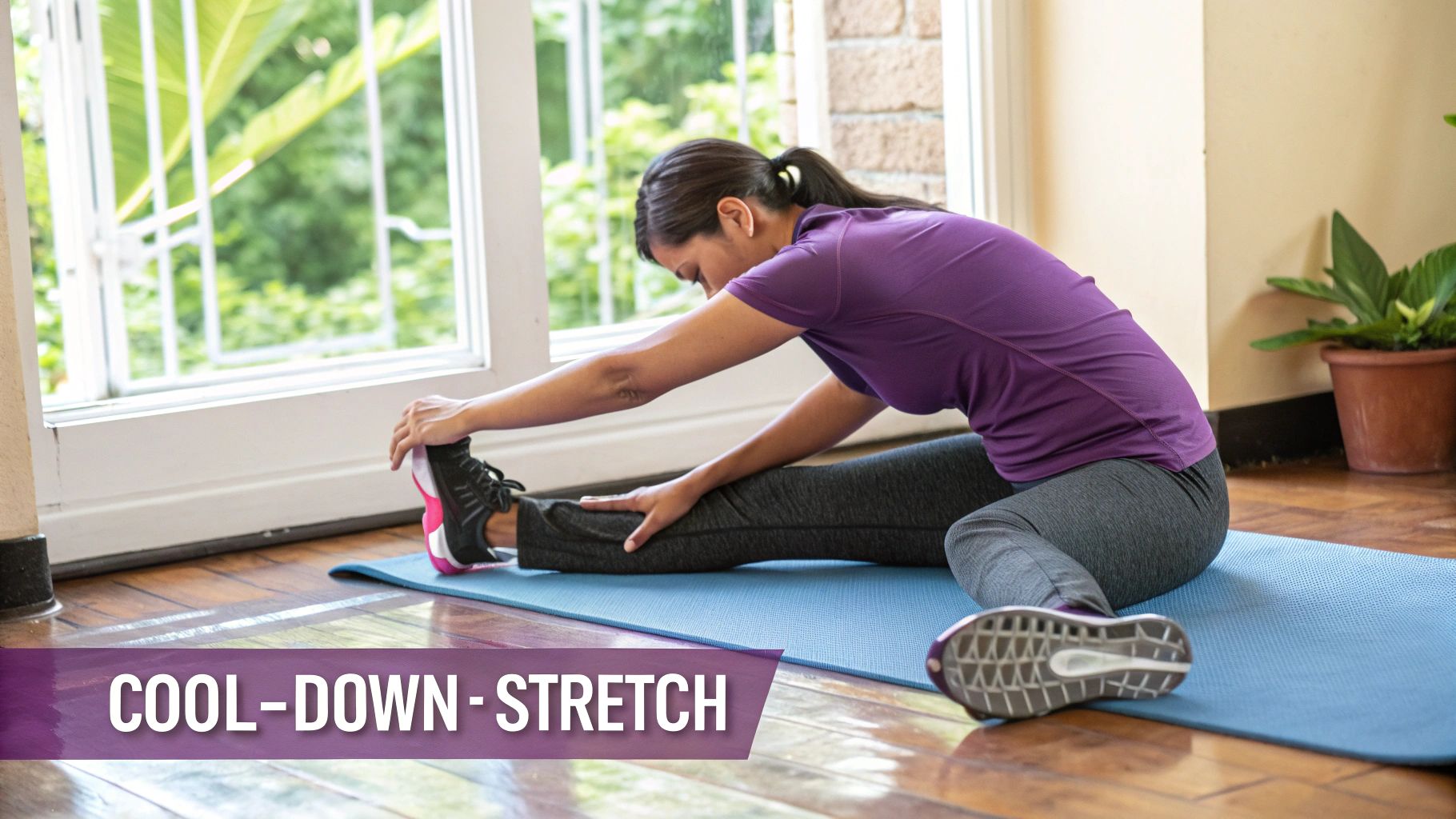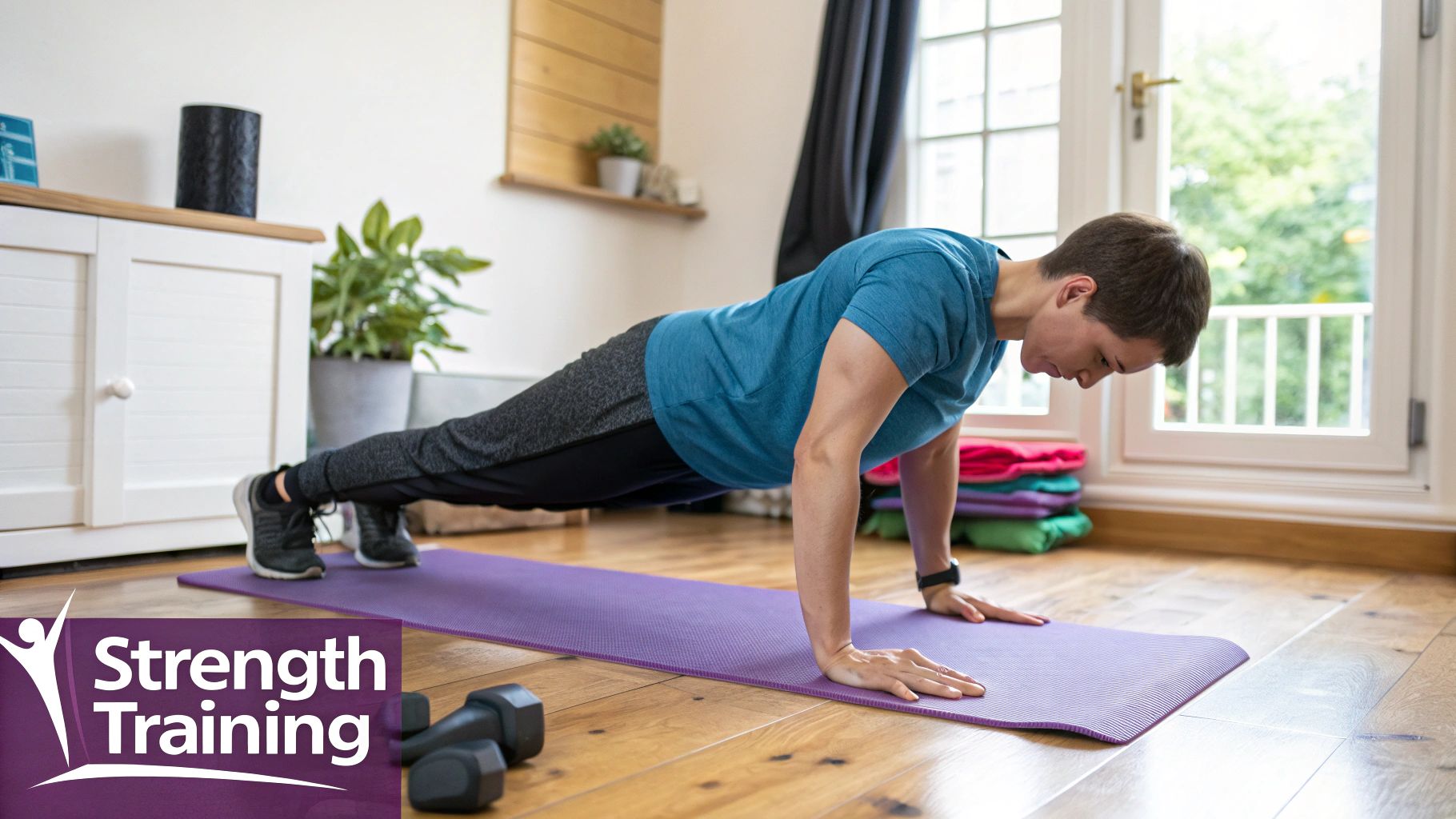
Easy Workout Routine at Home for Real Results
Building a fitness habit that sticks starts with an easy workout routine at home. Forget complicated gym schedules for now. The secret is starting with simple exercises you can do anywhere, building strength and confidence on your own terms.
Why a Simple Home Workout Is Your Best Start
Jumping into an intense fitness plan often leads to burnout. The magic of starting at home lies in its simplicity. You don't need a pricey gym membership or fancy equipment to see real results.

Focus on mastering fundamental movements in a space where you feel comfortable. This eliminates common excuses like "I don't have time" or feeling self-conscious. It makes consistency easy.
The numbers back this up. By 2023, 51% of U.S. exercisers preferred working out at home. This shift shows how much people value convenience. You can dig into more home fitness industry statistics to see the trend.
Fitness That Fits Your Life
The goal is to weave exercise into your daily life, not disrupt it. Fitness should work for you. A 20-minute session before coffee or a few exercises on your lunch break can build up to big results over time.
A truly effective workout plan is one you can actually stick with. By starting with an easy routine at home, you're building a habit that fits right into your life, setting yourself up for success in the long run.
Even small actions create momentum. You can build strength without a dedicated "workout" time by using tools that fit into your daily activities, like sitting at a desk or watching TV. A perfect example is a grip strengthener.
The Smart Grip Strengthener from our shop is designed for this. You can build forearm and hand strength while you're working or relaxing. It's a simple, effective tool that proves fitness doesn't have to be a huge event. This one piece of gear can be your first step toward tangible results.
Your Foundational Bodyweight Workout Plan
The core of a great home workout is a set of solid, foundational movements. These exercises build the strength and stability you need to progress safely, and you don't need any equipment to start.
First, always warm up. A proper warm-up gets blood flowing to your muscles, preventing injury and preparing your body for the workout. A few minutes of light cardio like jumping jacks is perfect.
This infographic lays out a simple way to get prepped for your main workout.
The 5 Core Exercises
For every exercise, focus on control and good form. It’s better to do 5 perfect reps than 15 sloppy ones. You can see a full video walkthrough of these moves in our Beginner Bodyweight Workout video.
1. Bodyweight Squats
Squats are the king of lower-body exercises, working your legs, glutes, and core. Start with feet shoulder-width apart, keep your chest high, and sink your hips back and down as if sitting in a chair.
2. Knee Push-Ups
Push-ups build strength in your chest, shoulders, and core. Starting on your knees is a perfect way to build up strength without straining your joints. Keep your body in a straight line from head to knees as you lower your chest to the floor.
3. Planks
Planks are amazing for deep core stability and posture. Prop yourself up on your forearms with elbows under your shoulders, and hold your body in a straight, rigid line. Squeeze your core and glutes tight.
4. Glute Bridges
This exercise activates glutes and hamstrings, which is crucial for supporting your lower back. Lie on your back with knees bent, and lift your hips toward the ceiling, squeezing your glutes at the top.
5. Jumping Jacks
Jumping jacks are a classic for a reason: they get your heart rate up, boost cardio fitness, and burn calories. Jump your feet out wide while swinging your arms overhead, then immediately jump back.
My biggest piece of advice? Consistency with these basic movements is what builds a real foundation. Focus on the quality of each rep, not the quantity. Nail your form first before you even think about going faster or doing more.
When these exercises feel too easy, it's time to add resistance. This is called progressive overload. The Adjustable Dumbbell Set is the perfect next step. You can start with a light weight for squats and glute bridges and gradually increase it as you get stronger, ensuring your workout remains challenging.
Your First Week At-Home Workout Schedule
Here’s a simple schedule for your first week. The goal is building a consistent habit, so rest days are included and are just as important as workout days for muscle growth.
| Day | Activity | Focus | Duration |
|---|---|---|---|
| Monday | Full Body Workout | Form & Control | 20-30 mins |
| Tuesday | Active Recovery | Light Walk / Stretching | 20-30 mins |
| Wednesday | Full Body Workout | Consistency | 20-30 mins |
| Thursday | Rest Day | Complete Rest | N/A |
| Friday | Full Body Workout | Feeling Stronger | 20-30 mins |
| Saturday | Active Recovery | Fun Activity (Hike, Bike) | 30+ mins |
| Sunday | Rest Day | Complete Rest | N/A |
This is your road map. After the first week, listen to your body and adjust as needed.
Fueling Your Fitness with Smart Nutrition
A great workout routine is only half the battle. Real transformation happens when you combine exercise with smart nutrition. You can't out-exercise a poor diet. The good news is, you don't need a complicated meal plan.
Think of food as fuel. It gives you the energy for your workouts and the materials your body needs to rebuild and recover. Without the right nutrients, you'll feel drained, and your muscles won't get stronger.
The Two Pillars: Protein and Hydration
For recovery, protein is essential. It helps repair the micro-tears in your muscles created during exercise, which is how they grow stronger. Aim to include a protein source with every meal.
Staying hydrated is just as crucial. Water flushes out waste from your muscles and transports nutrients. Even slight dehydration can increase soreness and fatigue. Sip water throughout the day.
Proper nutrition isn't about being perfect; it's about giving your body what it needs to succeed. If you only focus on two things, make it getting enough protein and staying hydrated. This is the fastest way to boost your recovery and see your hard work pay off.
Simple Fueling Before and After Your Workout
What you eat around your workouts can give you a serious edge. You don't need fancy supplements—just real food.
- Pre-Workout (30-60 mins before): A small snack with carbs and protein is perfect. Try a banana with peanut butter.
- Post-Workout (within 60-90 mins after): This is your recovery window. You need protein for muscle repair and carbs to restock energy. A smoothie is a fast, easy, and effective option.
Making a recovery shake is simple with the right tool. The Portable Electric Blender from our shop is a game-changer. Toss in protein powder, fruit, and liquid for a perfect recovery drink in seconds. No clumps, no mess.
To understand the bigger picture of energy balance, read our guide that explains what is a calorie deficit and how it fits into your goals.
Essential Gear for Better Home Workouts
While bodyweight exercises are great, a few key pieces of equipment can level up your home fitness game. The right gear adds new challenges and helps you progress.
The home fitness movement is growing. The global home fitness equipment market is projected to hit $19.79 billion by 2032. This shows the long-term value people see in having the right tools at home. We encourage you to read more about the future of fitness trends and strategies.

Upgrade with Versatile Equipment
As you get stronger, you'll need new challenges. Introducing versatile equipment is the best way to keep making progress without building a full home gym. One of the best investments you can make is an adjustable dumbbell set.
The Adjustable Dumbbell Set allows you to gradually increase the weight for exercises like squats, lunges, and overhead presses. It's a space-saving solution that grows with you, ensuring your easy home workout routine continues to deliver results.
The Easiest First Step
Sometimes, the best way to start is with the smallest possible action. You don't even need a dedicated workout time to begin building strength. Using a simple tool while you're already doing other activities can create incredible momentum.
The Smart Grip Strengthener is perfect for this. You can improve your grip and forearm strength while watching TV, sitting at your desk, or reading. It's an effortless way to integrate fitness into your daily life and prove that small, consistent actions lead to big changes.
How Technology Keeps You Motivated
The secret to long-term results is consistency. Technology can be your secret weapon, keeping you on track even when motivation fades. The right tools can be the difference between falling off and building a solid habit.
Simple, free fitness apps are great for logging sessions, tracking progress, and setting reminders. Seeing your progress laid out—whether it's lifting heavier or stringing together a week of workouts—gives you a reason to keep going.
Guided Workouts and Progress Tracking
One of the biggest hurdles with at-home workouts is feeling unstructured and alone. Guided videos change the game, adding structure and energy to your routine.
Following an instructor helps you stay engaged and ensures your form is correct, which is crucial for getting results and avoiding injury. Our dietexercise YouTube channel has a ton of guided videos that bring a class-like atmosphere right into your home.
Using technology to track your workouts isn't about adding complexity; it's about simplifying motivation. When you can visually see your strength increasing or your consistency streak growing, it creates a powerful feedback loop that reinforces your new healthy habit.
Pairing a simple tracking app with guided videos builds a powerful support system. It’s about using the phone in your pocket to build momentum, celebrate small wins, and turn your routine into a habit that sticks.
Your Top Home Workout Questions, Answered
Starting a new routine at home brings up questions. Getting clear answers can make the difference between sticking with it and giving up. Here are some of the most common questions.
How Many Days a Week Should I Actually Work Out?
If you're just starting, aim for three full-body workouts a week on non-consecutive days, like Monday, Wednesday, and Friday. This gives your muscles time to rest and repair, which is when they get stronger.
Don't underestimate recovery. Three focused 20-minute workouts are more effective than one exhausting hour-long session. Consistency always wins.
What If I Can't Do a Certain Exercise?
If an exercise feels too hard or causes pain, don't quit—modify it. Almost every exercise has an easier version that lets you build strength safely.
Choosing a modification isn't a weakness, it's a strategy. You're building a solid foundation for the future instead of risking an injury that sets you back.
For example, if a full push-up is too much, drop to your knees. You still work the same muscles with less weight. For more ideas on how to adjust moves, check out our demonstration videos.
When Will I Actually Start Seeing a Difference?
You’ll likely feel a change before you see one. After a few weeks, you might notice better sleep or more energy. The workout itself will start to feel easier.
For visible results, like a more toned look, you’re typically looking at four to eight weeks of consistent work and proper nutrition. Sticking to your schedule and fueling your body right will accelerate your progress.
Here at Diet and Exercise, we’re all about helping you succeed on your terms with the right gear and guidance. Check out our shop to find everything you need to build out your perfect home workout space.
